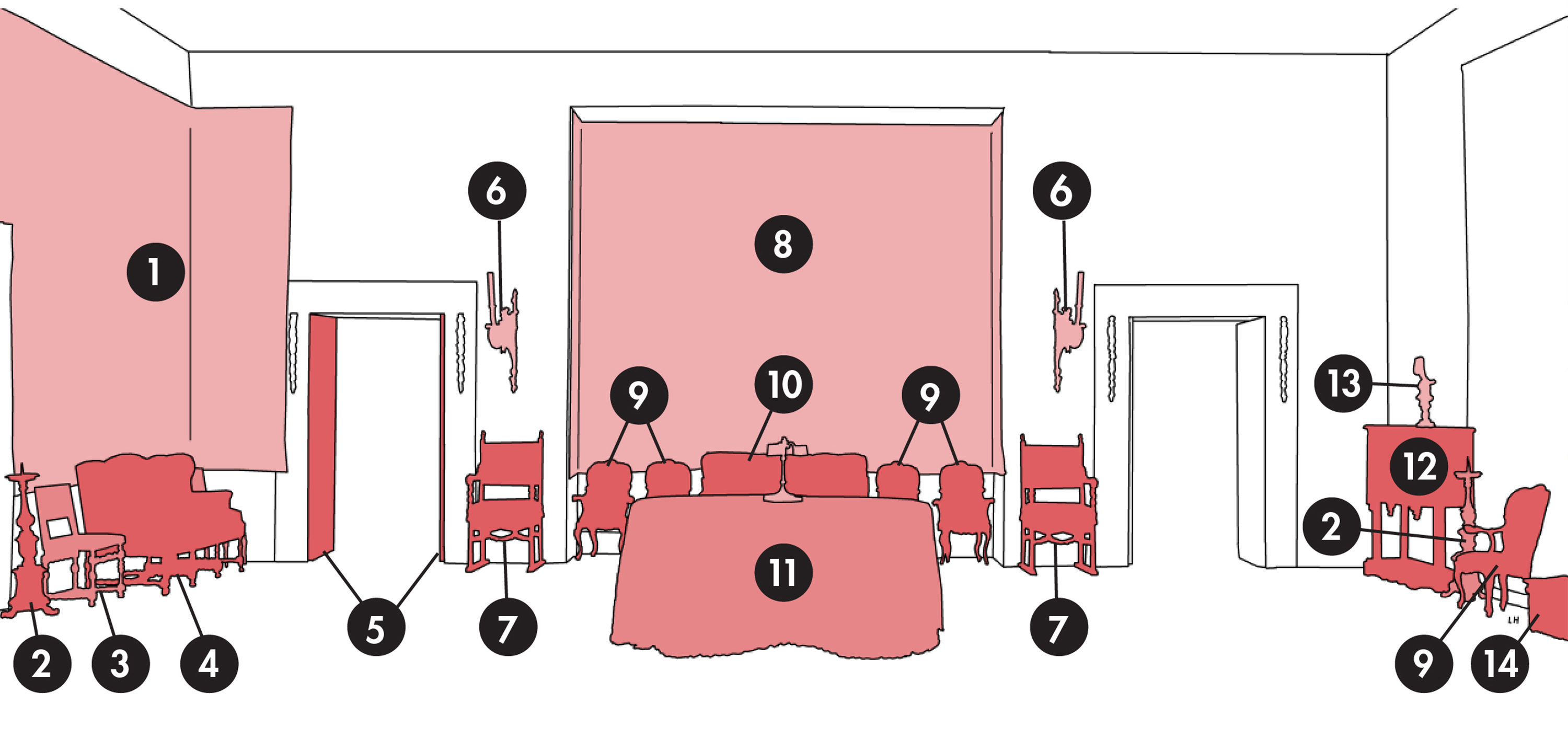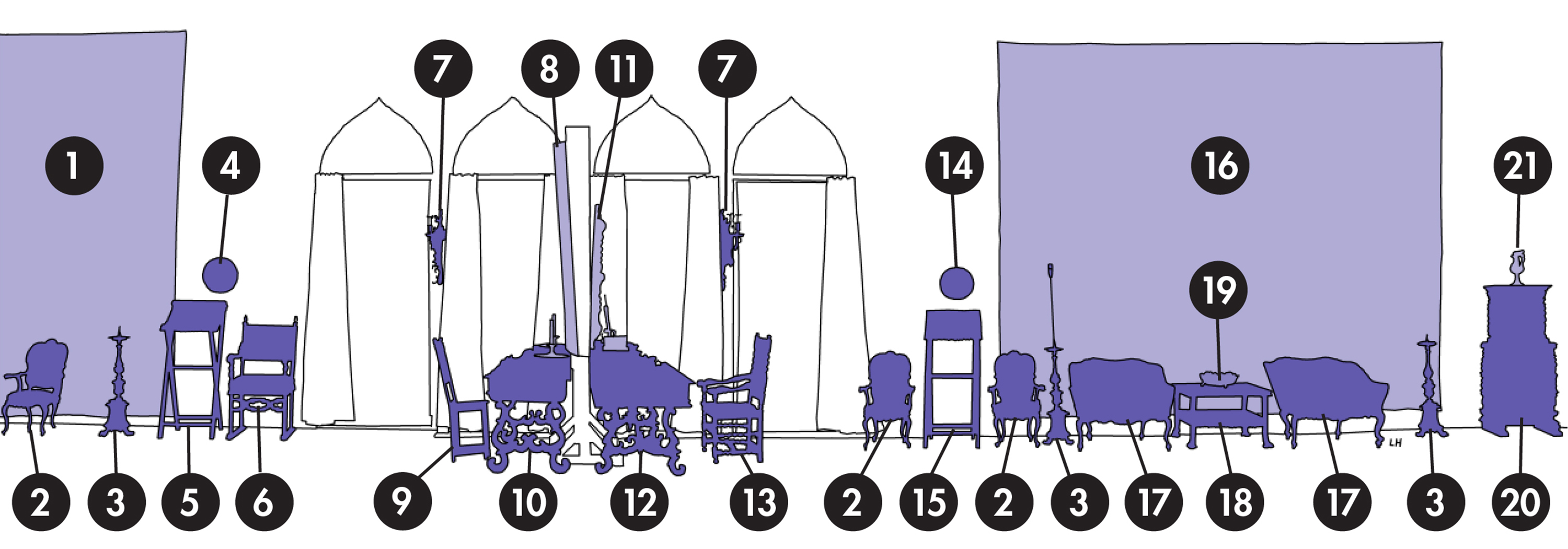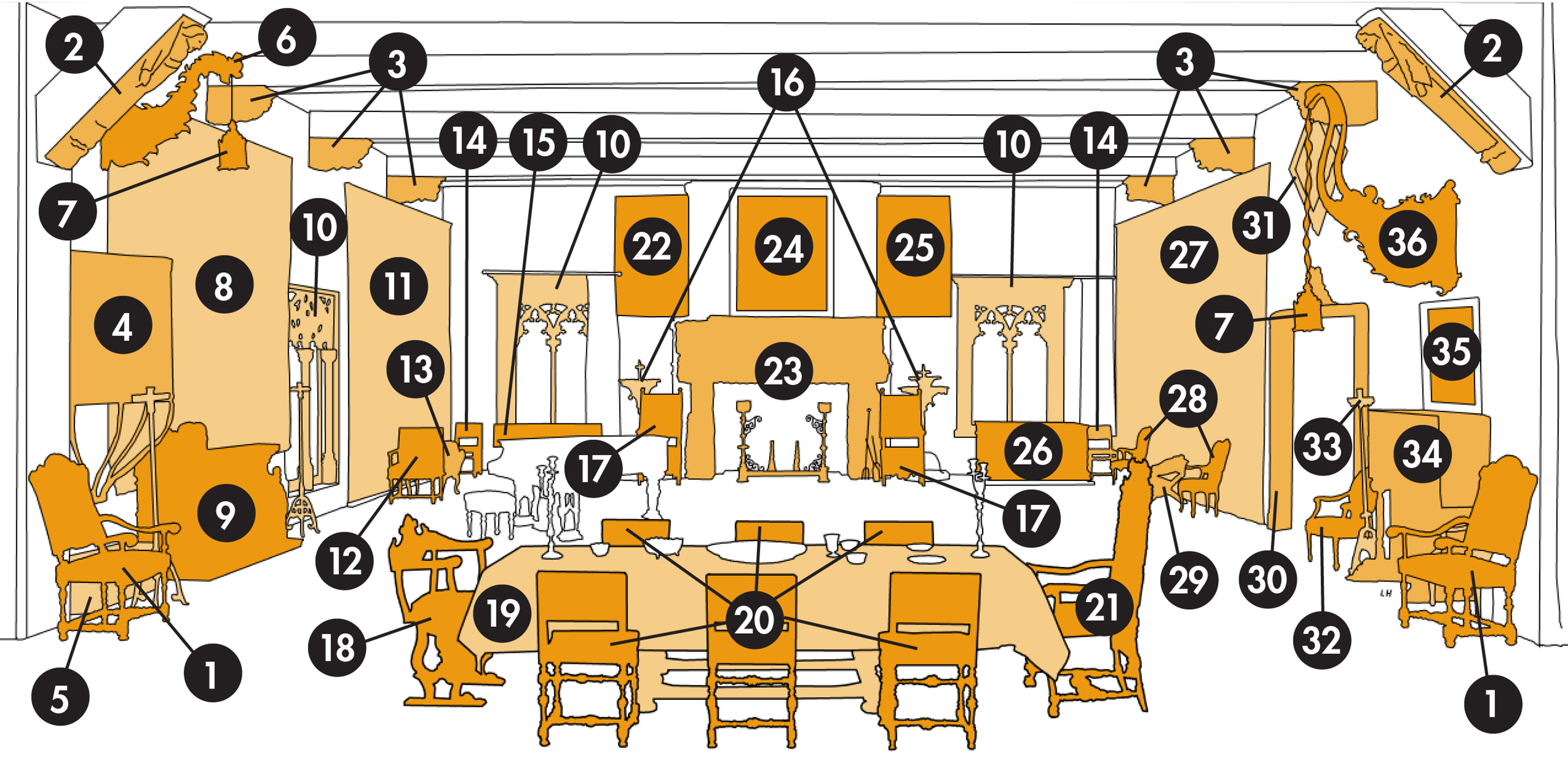



1. Tapestry: Abimelech Restores Sarah to Abraham,
1550–1600. Attributed to Jan van Tiegen (active Brussels, about 1550). Silk and wool
2. Torchère (six in this room).
Italian, 16th century. Copper alloy
3. Side Chair with original upholstery (four in this room).
Netherlandish, 1750–1765. Metal-leafed and painted leather
4. Sofa.
English, early 19th century. Wood covered with wool and silk needlework (French or Netherlandish, 1675–1725)
5. Doors.
Italian, 16th century. Wood
6. Candle Bracket.
Iron and copper
7. Armchair (five in this room).
Italian, late 19th century. Painted and gilded walnut and chestnut, gilded brass
8. Tapestry: Abraham Receives Rebecca,
1550–1600. Attributed to Jan van Tiegen (active Brussels, about 1550). Silk and wool
9. Armchairs (twelve in this room).
Northern Italian, mid-18th century. Walnut, with poplar and pine
10. Sofa.
American, 19th century. Wood with modern interpretation of original 17th-century Persian embroidery and velvet upholstery.
11. Oval Table.
Italian, late 19th century with 17th century legs. Walnut
On the table:
- Oil Lamp with implements for smoking. Italian, Venice, 19th century. Silver
12. Credence.
French, about 1500. Walnut
13. Ewer.
Flemish, 19th century. Yellow bronze
14. Strongbox.
Dutch or Spanish, 16th century. Iron
On the floor:
Isabella Gardner commissioned the floor tiles in this room from Henry Mercer’s Moravian Pottery and Tile Works in Doylestown, Pennsylvania. Look for more Mercer tiles on the floors of the Dutch and Gothic Rooms.
1. Tapestry: A Messenger Brings Cyrus a Letter Concealed in a Hare,
about 1535–1550. Workshop of Jan Moy (active Netherlands, about 1525). Silk and wool
2. Armchair (twelve in this room).
North Italian, mid 18th century. Walnut, with poplar and pine
3. Torchère (six in this room).
Italian, 16th century. Copper alloy
4. Plate: Grape Vines.
Italian, Vietri sul Mare, 19th century. Brass
5. Lectern with arms of Pope Clement IX (reigned 1667–69).
Italian. Wood with embroidered velvet
6. Armchair (five in this room).
Italian, late 19th century. Painted and gilded walnut and chestnut, gilded brass
7. Candle bracket (two).
Italian, 16th century. Painted wrought iron
8. Saint Engracia,
about 1474. Bartolomé Bermejo (Spanish, about 1436–about 1498). Oil, tempera, and gold on panel
9. Chair.
Northern Italian, 17th century. Walnut
10. Writing Table.
Central Italian, 17th–18th century. Walnut and iron
On the table (left to right):
- Candleholders, about 1909, Ignaz Marcel Gaugengigl (German, 1855–1932). Pewter
- Seal, Italian. Brass with wooden handle
- Box, Japanese. Lacquer with mother-of-pearl.
- Reading Glass, English, late 19th century. Silver
- Five-piece Desk Set, Italian, Venice, 18th century. Silver
- Box with Virgin and Child, Russian. Silver
- Sealing Wax
- Pen Holder. Leather
- Binding with arms of a cardinal. Tooled leather
- Tray, Portuguese, 18th century. Silver
- Two Quill Pens with a coat of arms. Silver and feather
- Box, Indian, late 19th century. Silver
- Cup, probably Swedish, early 19th century. Silver
- Binding with the arms of Pope Clement XII. Tooled leather
- Binding. Tooled leather
- Paper Cutter with initials of John Lowell Gardner, Jr., late 19th century. Ivory
- Fan, Japanese
- Candle bracket. Wrought iron
11. Pope Innocent X,
about 1650. After Diego Velázquez (Spanish, 1599–1660). Oil on canvas
12. Writing table.
Central Italian, about 1700. Walnut with bronze fittings
On the table (left to right):
- Box containing incense, late 19th century. Wood
- Binding with the arms of a prelate of the Cavazzi family. Tooled leather
- Lock with key. Iron
- Box with Chinese poem on sliding cover, mid-19th century. Wood
- Snake. Soapstone
- Portfolio. Tooled leather
- Album with Chinese characters
- Round Box, late 19th century. Wood and lacquer
- Round Box, late 19th century. Jade
- Candle Stand. Brass
13. Armchair.
English or Welsh, late 17th century. Wood
14. Plate: Annunciation.
German, Nuremberg, 17th century. Brass
15. Lectern with the arms of the Colonna family.
Italian. Wood with embroidered velvet
16. Tapestry: Queen Tomyris Learns that her Son Spargapises has been Taken Captive by Cyrus,
about 1535–1550. Workshop of Jan Moy (active Netherlands, about 1525). Silk and wool
17. Wide Armchair.
Italian, late 19th century. Poplar with velvet
18. Table.
Italian, 19th century. Wood with silk damask
19. Dish.
Japanese, 19th century. Copper stained to resemble bronze
20. Cabinet.
Italian, Liguria, late 16th century. Walnut on a 19th-century stand
21. Ewer.
South German, 15th century. Brass
On the floor:
Isabella Gardner commissioned the floor tiles in this room from Henry Mercer’s Moravian Pottery and Tile Works in Doylestown, Pennsylvania. Look for more Mercer tiles on the floors of the Dutch and Gothic Rooms.
1. Armchair (two in this room).
Italian, 19th century. Walnut
2. Clerical Figure.
English, 17th century. Walnut
3. Corbel carved in human and animal grotesque forms (six).
English, 14th century. Pine
4. Pulpit.
Spanish or French, 14th or 15th century. Wrought iron and paint
5. Chest.
Spanish, 16th century. Walnut
6. Bracket.
German, 17th century. Wrought iron.
7. Lantern.
Italian. Brass and glass
8. Tapestry: Abraham’s Servant Presents Jewels and Raiment to Rebecca,
1550–1600. Attributed to Jan van Tiegen (active Brussels, about 1550). Silk and wool
9. Choir Stalls.
French, 14th–15th century and later. Oak
10. Window.
Spanish (?), 15th–16th century. Stone
11. Tapestry: Queen Tomyris Receives the Messenger who Brings from Cyrus a Proposal of Marriage,
about 1535–1550. Workshop of Jan Moy (active Netherlands, about 1525). Silk and wool
12. Armchair.
French (?), 19th century. Walnut
13. Armchair.
Italian, Venice, late 19th century. Walnut
14. Side Chair with original upholstery (four in this room).
Netherlandish, 1750–65. Metal-leafed and painted leather
15. Sacristy bench.
Spanish. Pine
16. Candelabra.
Flemish, late 15th century. Iron
17. Armchair.
Italian, Milan, late 19th century. Walnut and bronze
18. Armchair.
Italian, about 1900. Walnut
19. Table.
Dutch, 17th century. Oak
On the table (left to right):
- Two Candelabra, once the property of Isabella Gardner’s grandmother, Isabella Tod Stewart, English, 19th century. Silver-plated copper
- Two Saucers and Bowl, Japanese, 19th century. Porcelain
- Bowl, Japanese, 19th century. Copper alloy
- Plate, modern. Majolica
- Goblet, Bohemian, 19th century. Glass
- Two sets of Bowls with Plates, Japanese, 20th century. Lacquer
20. Side Chair
with reproduction 18th-century Netherlandish upholstery (six in this room). Metal-leafed and painted leather
21. Armchair.
English, 17th century. Wood
On the chair:
- Cushion. Italian, 17th century. Velvet with gold embroidery
22. Trumpeters.
Flemish (probably Brussels), 1510–25. Silk and wool
23. Fireplace.
French, around 1500. Painted limestone
In the fireplace:
- Fire Screen, Andirons, and Fire Back by Henry Mercer (American, 1856–1930). Wrought iron and recast iron
24. Archangel Michael,
about 1470. Pedro García de Benabarre (Spanish, active 1445–96). Tempera and gold on wood
25. Ladies Conversing with a Gentleman.
Flemish (probably Brussels), 1510–25. Silk and wool
26. Carved Chest.
North European, 17th century. Oak
27. Tapestry: King Astyages Commands Harpagos to Do Away With the Infant Cyrus,
about 1535–1550. Workshop of Jan Moy (active Netherlands, about 1525). Silk and wool
28. Armchair (twelve in this room).
North Italian, mid-18th century. Walnut, with poplar and pine
29. Low Armchair.
Italian, late 19th century. Walnut
30. Doorway.
French or Flemish, partly modern in the style of the 15th century. Wood
31. Funeral coat of arms of Mary Queen of Scots,
1915. Made for Mrs. Gardner by Pierre de Chaignon la Rose (American, 1871–1940). Paint, gold, and silver on wood
32. Armchair.
Central Italian, last quarter of the 18th century. Painted and gilded walnut
33. Torchère (four in this room).
Iron
34. Barqueño (writing desk and cabinet).
Spanish, 17th century. Painted and gilded walnut, ivory, and iron
35. La Gitana,
1920. Louis Kronberg (American, 1872–1965). Oil on canvas
36. Bracket.
German (?), 17th century. Iron
The piano is a New York Steinway & Sons model B made in 1903. Morris Carter, the museum’s first director, gave the piano to the museum in 1936.
On the floor:
Isabella Gardner commissioned the floor tiles in this room from Henry Mercer’s Moravian Pottery and Tile Works in Doylestown, Pennsylvania. Look for more Mercer tiles on the floors of the Dutch and Gothic Rooms.
1. Tapestry: King Astyages Places Harpagos in Command of His Army,
about 1535–1550. Workshop of Jan Moy (active Netherlands, about 1525). Silk and wool
2. Armchair (twelve in this room).
North Italian, mid-18th century. Walnut, with poplar and pine
3. Table.
English, late 17th century. Wood
4. The Ascension of Christ.
Russian, Novgorod, 15th century. Tempera and gold on wood
5. Holy Water Stoup.
19th century. Silver
6. Silk Panel,
early 20th century. Raymond Duncan (American, 1875–1966). Painted silk
7. Torchère (six in this room).
Italian (?), 16th century. Copper alloy
8. Tapestry: Abraham dismisses Hagar and Ishmael,
1550–1600. Attributed to Jan van Tiegen (active Brussels, about 1550). Silk and wool
9. Plate depicting the Temptation of Adam and Eve.
German, Nuremberg, 15th century (?). Brass
10. Head of Christ.
South German, second half of the 15th century. Painted lindenwood
11. Leaves from a Missal of Pope Clement VII,
about 1523–27. Follower of Matteo da Milano (Italian, active about 1492–1523). Paint and gold on vellum
12. Armchair (five in this room).
Italian (?), late 19th century. Painted and gilded walnut and chestnut, gilded brass
13. Three Plates depicting (from left to right): Adam and Eve, Stags, and the Annunciation.
German, 15th–17th centuries. Brass
14. Candle Bracket.
Wrought iron
15. Bench.
Italian, late 19th century. Walnut
16. Candelabrum representing the Madonna della Misericordia.
Central Italian, 1582. Painted and gilded wood on a later wood pedestal
17. Dresser.
English, late 17th century. Oak and walnut veneer
Covering the dresser:
- Two Men Handling Cargo. Flemish, Brussels, 1750–75. Wool and silk
On the dresser (front to back):
- Inlaid Book Stand, Indian, probably 18th century
- Manuscript of The Divan of Hafiz, Persian, 1489–90, in a 19th century binding
- Book of autographs, with a silver-set emerald, given to Isabella Gardner on her 69th birthday (1909)
- Box in the shape of a book, Persian (?). Wood and lacquer
18. Processional Cross.
Italian, about 1450. Partly gilded silver on wood core
19. Holy Water Stoup.
Spanish (?), 17th or 18th century. Silver
20. Tapestry: Rebecca Gives Water to Abraham’s Servant,
1550–1600. Attributed to Jan van Tiegen (active Brussels, about 1550). Silk and wool.
21. Table.
Modern, in Spanish style. Oak
22. On the table reproductions of the original manuscripts:
- a. The Candle Clock, leaf from al-Jazari’s Book of Knowledge of Ingenious Mechanical Devices, Egyptian, 1354
- b. Leaf from an Arabic translation of De Materia Medica by Dioscurides, Baghdad, 1224
- c. A Water Clock, leaf from al-Jazari’s Book of Knowledge of Ingenious Mechanical Devices, Egyptian, 1354
- d. An Hydraulic Device, leaf from al-Jazari’s Book of Knowledge of Ingenious Mechanical Devices, Egyptian, 1354
- e. Kay Kaus Captured by the Divs, leaf from a manuscript of the Book of Kings of Ferdowsi, Persian, mid-15th century
- f. Rustam Fighting with Suhrab, leaf from a manuscript of the Book of Kings of Ferdowsi, Persian, mid-15th century
- g. Two photographs of leaves from the Book of Knowledge of Ingenious Mechanical Devices of al-Jazari in the Museum of Fine Arts, Boston: The Reckoner’s Bloodletting Basin and Device for Display at a Drinking Party
- h. Catalogue of these miniatures handwritten by Isabella Gardner, 1915
23. Candlestick.
17th century. Iron
24. Tapestry: Abimelech Restores Sarah to Abraham,
1550–1600. Attributed to Jan van Tiegen (active Brussels, about 1550). Silk and wool
25. Side Chair with original upholstery (four in this room).
Netherlandish, 1750-1765. Metal-leafed and painted leather
26. Sofa.
English, early 19th century. Wood covered with wool and silk needlework (French or Netherlandish, 1675–1725)
On the floor:
Isabella Gardner commissioned the floor tiles in this room from Henry Mercer’s Moravian Pottery and Tile Works in Doylestown, Pennsylvania. Look for more Mercer tiles on the floors of the Dutch and Gothic Rooms.